Chapter: Civil : Railway Airport Harbour Engineering : Railway Engineering : Curves and Superelevation
Railway Engineering: Safe Speed on Curves
Safe
Speed on Curves
For all practical purposes safe speed means a speed which
protects a carriage from the danger of overturning and derailment and provides
a certain margin of safety. Earlier it was calculated empirically by applying
Martin's formula:
For BG
and MG
Transitioned curves
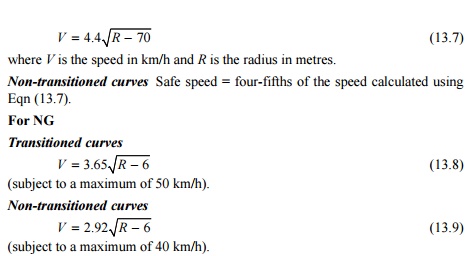
Indian Railways no longer follows this concept of
safe speed on curves or the stipulations given here.
1.New Formula for
Determining Maximum Permissible Speed on Transitioned Curves
Earlier, Martin's formula was used to work out the maximum
permissible speed or safe speed on curves. This empirical formula has been
changed by applying a formula based on theoretical considerations as per the
recommendations of the committee of directors, chief engineers, and the ACRS.
The maximum speed for transitioned curves is now determined as per the revised
formulae given below.
On Broad Gauge

where V is the maximum speed in km/h, Ca
is the actual cant in mm, Cd is the permitted cant deficiency
in mm, and R is the radius in m. This equation is derived from Eqn
(13.6) for equilibrium superelevation and is based on the assumption that G
= 1750 mm, which is the centre-to-centre distance between the rail heads of a
BG track with 52-kg rails.
On Metre Gauge

This is based on the assumption that the centre-to-centre
(c/c) distance between the rail heads of an MG track is 1058 mm.
Narrow Gauge (762 min.)

2.New Criteria for
Determining Maximum Speed on Curves Without Transition
As per the procedure being
followed at present, the determination of the maximum permissible speed on
curves without transitions involves the concept of virtual transitions.
The linear velocity of a train moving with uniform velocity on a straight track
begins to change into angular velocity as soon as the first bogie reaches the
tangent point. This change continues till the rear bogie reaches the tangent
point, at which moment the train acquires full angular velocity. The change in
the motion of the train from a straight line to a curve takes place over the
shortest distance between the bogie centres and is considered a virtual
transition. Normally, this distance is l4.6 m on BG, 13.7 m on MG, and 10.3
m on NG, commencing on a straight line at half the distance before the tangent
point and terminating on the curve at half the distance beyond the tangent
point. The deficiency of cant is considered as being gained over the length of
the virtual transition and the cant has to be gained in a similar manner. The
cant gradient must not be steeper than 1 in 360 on BG and 1 in 720 on MG and NG
under any circumstance.
The safe speed should be worked
out on the basis of the the cant that can be practically provided based on
these criteria, and increased by the permissible amount of cant deficiency. In
the case of non-transitioned curves, where no cant is provided, the safe speed
for the curve can be worked out by calculating the permissible cant deficiency
after taking into consideration the rate at which the cant deficincy is gained
or lost over the virtual transition.
3 Maximum Permissible Speed on a Curve
The maximum permissible speed on
a curve is the minimum value of the speed that is calculated after determining
the four different speed limits mentioned here. The first three speed limits
are taken into account for the calculation of maximum permissible speed,
particularly if the length of the transition curve can be increased. For
high-speed routes, however, the fourth speed limit is also very important, as
cases may arise when the length of the transition curve cannot be altered
easily.
(i) Maximum
sanctioned speed of the section This is the maximum permissible
speed authorized by the commissioner of railway safety. This is determined
after an analysis of the condition of the track, the standard of interlocking,
the type of locomotive and rolling stock used, and other such factors.
(ii) Maximum speed
of the section taking into consideration cant deficiency
This is the speed calculated
using the formula given in Table 13.5. First, the
equilibrium speed is decided after taking various factors into
consideration and the equilibrium superelevation (Ca)
calculated. The cant deficiency (Cd) is then added to the
equilibrium superelevation and the maximum speed is calculated as per this
increased superelevalion (Ca + Cd).
Table 13.5 Calculation of
permissible speed on curves

(iii) Maximum
speed taking into consideration speed of goods train and cant excess Cant (Ca)
is calculated based on the speed of slow moving traffic, i.e., goods
train. This speed is decided for each section after taking various factors into
account, but generally its value is 65 km/h for BG and 50 km/h
for MG.
The maximum value of cant excess (Ce)
is added to this cant and it should be ensured that the cant for the maximum
speed does not exceed the value of the sum of the actual cant + and the cant
excess (Ca + Ce).
(iv) Speed
corresponding to the length of the transition curves This is
the least value of speed calculated after taking into consideration the
various lenths of transition curves given by the formulae listed in Table 13.6.
The following points may be noted when calculating
the maximum permissible speed on a curve.
(a) Criterion
(iv) is to be used only in cases where the length of the transition curve
cannot be increased due to site restrictions. The rate of change of cant or cant
deficiency has been permitted at a rate of 55 mm/sec purely as an interim
measure for the existing curves on BG tracks.
(b) For
high-speed BG routes, when the speed is restricted as a result of the rate of
change of cant deficiency exceeding 55 mm/sec, it is necessary to limit the
cant deficiency to a value lower than 100 mm in such a way that optimum results
are obtained. In this situation, the maximum permissible speed is determined
for a cant deficiency less than 100 mm, but gives a higher value of the maximum
permissible speed. This concept is further explained with the help of the
following solved problems.
Table 13.6 Various
lengths of transition curves to be considered when calculating speed

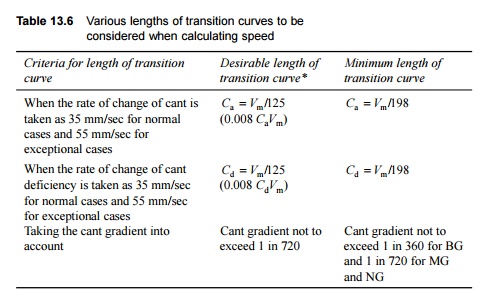
* Notation used in the table: Ca
is the value of actual cant in mm, Vm is the maximurm
permissible speed in km/h, and Cd is the cant deficiency in
mm.
Example 13.1 Calculate
the superelevation and the maximum permissible speed for a 2 o BG
transitioned curve on a high-speed route with a maximum sanctioned speed of 110
km/h. The speed for calculating the equilibrium superelevation as decided by
the chief engineer is 80 km/h and the booked speed of goods trains is 50 km/h.
Solution
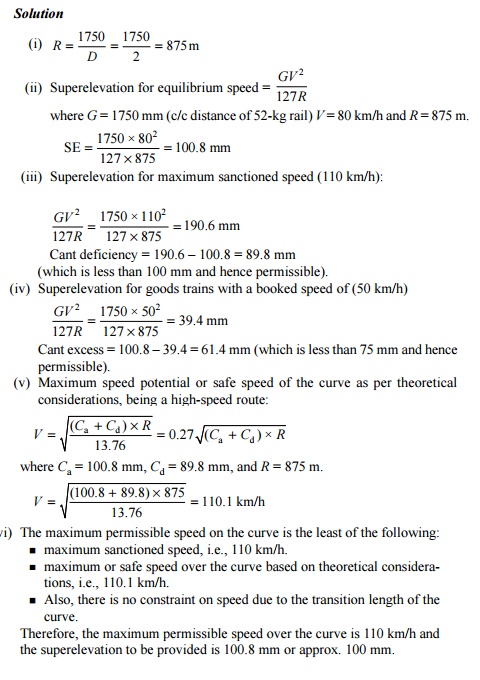
Simplified method of calculating
permissible cant and speed
Often a simplified method is used
for calculating the permissible cant and the maximum permissible speed in the
field. This simplified method is applicable to most cases except those
involving very flat curves.
Step 1 Calculate
the cant for the maximum sanctioned speed of the section, say, 110
km/h, using the standard formula C = GV
2 /127R . This is C110.
Step 2 Calculate
the cant using the same standard formula as for the slowest traffic, i.e.,
for a goods train which may be running at, say, 50 km/h. This is C50.
To this add cant excess. This becomes C50 + Ce.
Step 3 Calculate
the cant for equilibrium speed (if decided) using the same standard formula.
Let it be 80 km/h. This value is C80.
Step 4 Adopt the lowest of the three
values obtained from the preceding steps and that becomes the
permissible cant (Ca). The three values are C110,
C50 + Ce, and C80. Step
5 Taking this cant value (Ca), add the cant
deficiency and find the maximum permissible speed using the Eqn
(13.10).
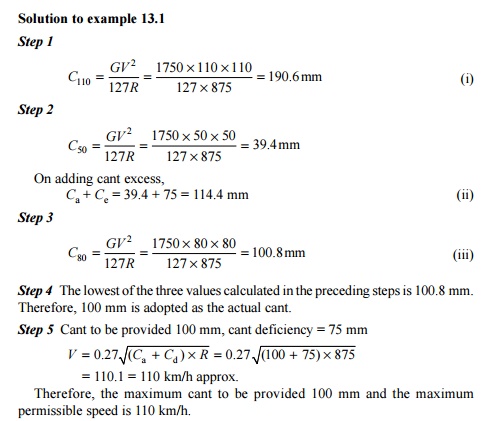
Example 13.2 Calculate the
superelevation, maximum permissible speed, and transition length for a
3 o curve on a high-speed BG section with a maximum sanctioned speed of 110
km/h. Assume the equilibrium speed to be 80 km/h and the booked speed of the
goods train to be 50 km/h.
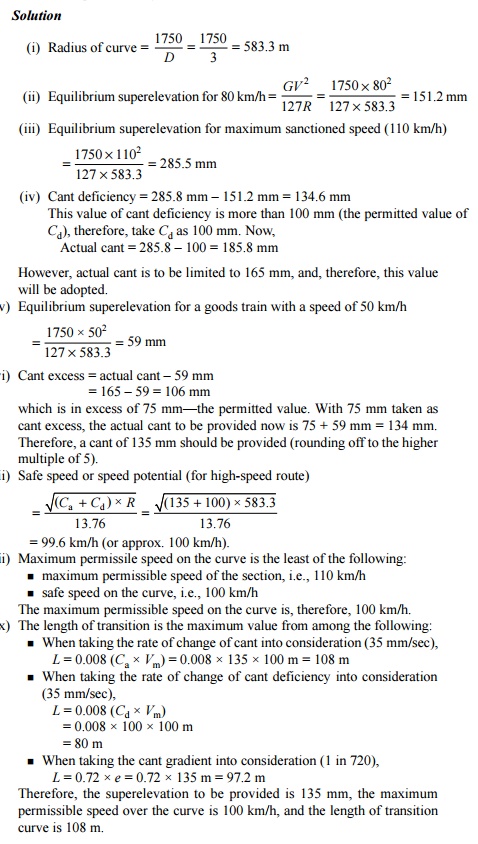
Example 13.3 Calculate
the maximum permissible speed on a curve of a high speed BG group A
route having the following particulars: degree of the curve = 1 o ,
superelevation = 80 mm, length of transition curve = 120 m, maximum speed
likely to be sanctioned for the section =160 km/h.

Example 13.4 Calculate
the maximum permissible speed on a 1 o curve on a Rajdhani route with a
maximum sanctioned speed of 130 km/h. The superelevation provided is 50 mm and
the transition length is 60 m. The transition length of the curve cannot be
increased due to the proximity of the yard.
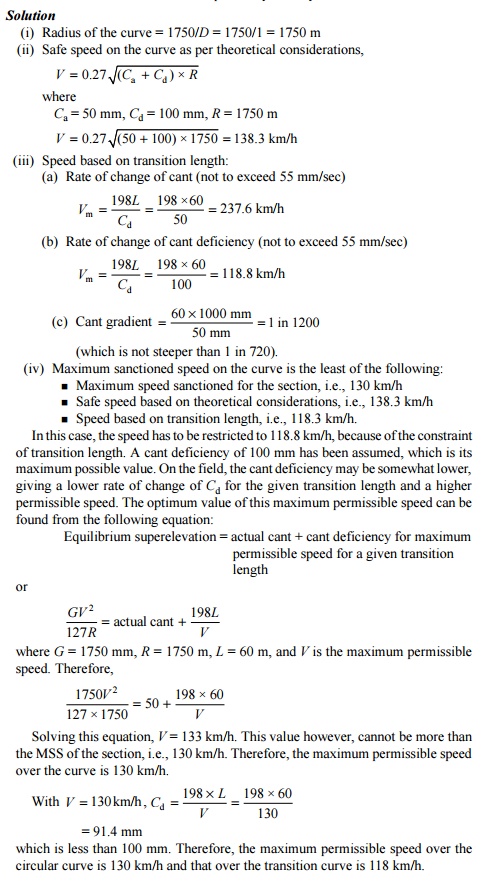
Example 13.5 A BG branch line track
takes off as a contrary flexure through a 1 in 12 turnout from a main
line track of a 3 o curvature. Due to the turnout, the maximum permissible speed
on the branch line is 30 km/h. Calculate the negative superelevation to be
provided on the branch line track and the maximum permissible speed on the main
line track (when it takes off from a straight track).
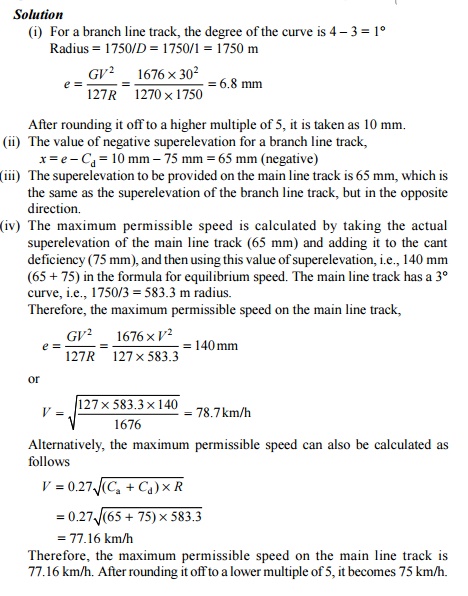
Related Topics